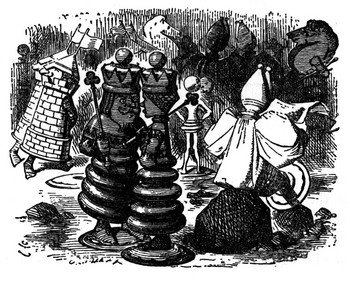
Surfing around, I came across this page, which presents the names given to the chess pieces in other languages:
foreign names of chess pieces.
It is very interesting to see how many cross-relationships there are among these names. To start with, all of them seem to agree on the fact that the most important piece is the King, and they use that name in each language (Dutch: koning; German: könig; French: roi; Italian: re; Spanish: rey; Russian: король [korol]; Arabic*: شاه [shah]). The expression announcing that the King is in danger (check!) or dead (checkmate!) comes from the same root than shah, sheikh, etc.
Starting with the Queen we can see some differences. English and Russian coincide on naming her Queen, but the other languages prefer to call her “Lady”.
The piece that looks like a tower is called like that in most of these languages, with the exception of Russian which calls it “ship” (ладья [ladja]), and English itself, which calls it Rook. I don’t know the etymology of this word, but I find it exceedingly curious that a rook is a big bird similar to a crow which is one of the most distinctive characteristics of the Tower of London! Coincidence?
Pawns are workers, farmers or tokens, and the figure that any three-year-old would recognize as a horsie is called “horse” in most languages, although English uses a fancier Knight and German says that it is a Springer (jumper), which horses do very well (jump, that is)
And finally we arrive at the strangest of the divergences between these languages, the still unmentioned Bishop. In Dutch and German they are runners, in French it is called fool (I swear! Look it up!), in Italian it is a standard bearer and in Russian and Arabic it is an elephant. The word used in Spanish is alfil which currently doesn’t have any other meaning than the chess piece. It is interesting, though, that “fil” is elephant in Arabic, and almost certainly alfil comes from the elephant.
To close the post, I’m presenting you with a home-made translation of an outstanding sonnet by Borges inspired by this wonderful game:
Fainting King, slanting Bishop, always fierce
Queen, straightforward Tower and cunning Pawn;
on the black and white colors of the squares
they seek and fight their ever armed war.
They are never aware that is the player’s
hand that marks who will die or who will kill.
They are never aware of rules that force
their day to day affairs and their free will.
Also the player is a prisoner
of other board (Omar pronounced this lot)
with black nights and white days, his destiny.
The player moves the piece, God moves the player.
What god behind this God does start the plot
of dust and time and dream and agony?
Readers lucky enough to understand Spanish might want to read the exquisite original with all its nuances and subtleties, rhymes and rhythms that no translation can ever convey completely.
* As it was pointed out in a recent comment, this is actually Persian. Apologies for this mistake.





